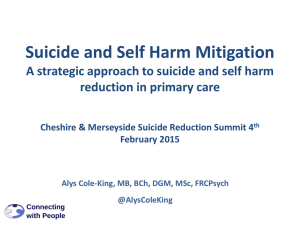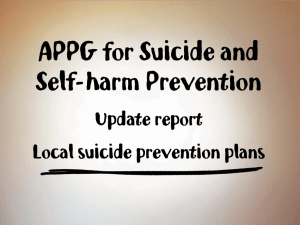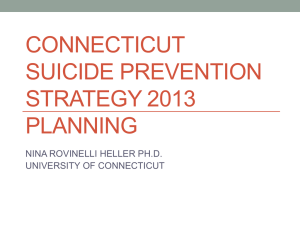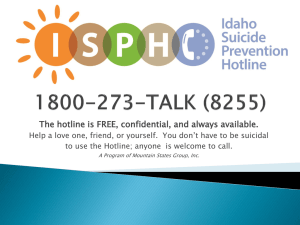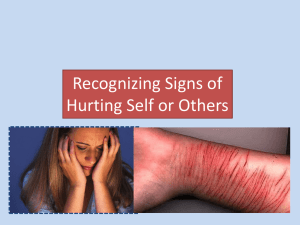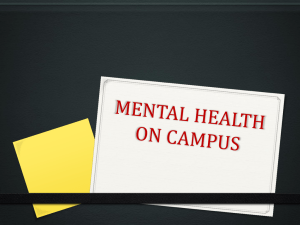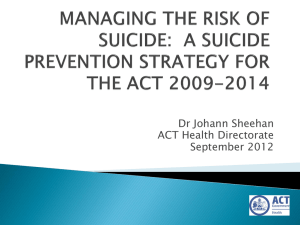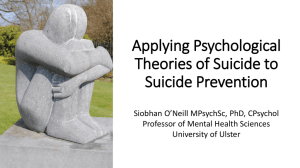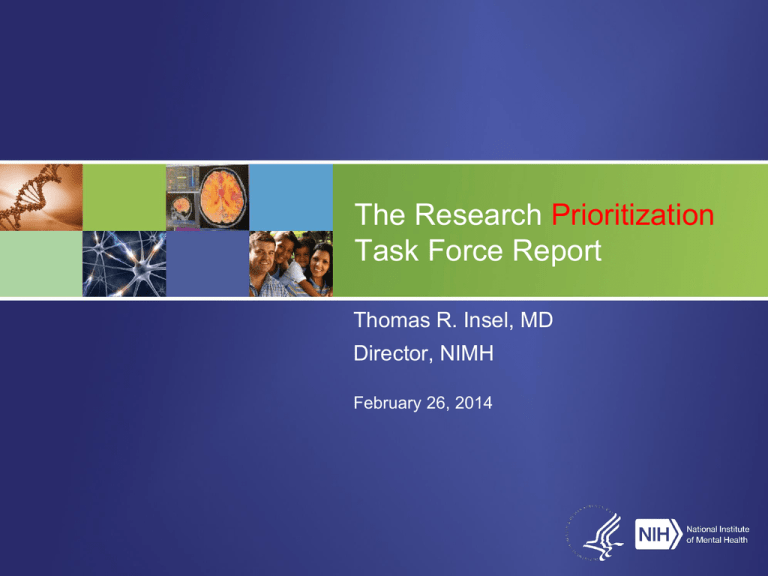
The Research Prioritization
Task Force Report
Thomas R. Insel, MD
Director, NIMH
February 26, 2014
National Strategy for Suicide Prevention
Goal 12. Promote and support
research on suicide prevention.
Objective 12.1: Develop a national suicide
prevention research agenda with
comprehensive input from multiple
stakeholders.
Objective 12.2: Disseminate the national
suicide prevention research agenda.
Objective 12.3: Promote the timely
dissemination of suicide prevention research
findings.
Objective 12.4: Develop and support a
repository of research resources to help
increase the amount and quality of research
on suicide prevention and care in the
aftermath of suicidal behaviors.
Suicide Rates have not decreased since 1990
Fact: Homicides have dropped from 9.8/100,000 in 1992 to 4.8/100,000 in
2010 (<15,000/yr).
Fact: Suicides have not decreased over past 2 decades.
14
12
Rate Per 100,000
10
8
6
4
Homicide
2
Suicide
0
1990
1992
1994
1996
1998
2000
2002
SOURCES: Bureau of Justice Statistics (homicide); CDC (suicide)
3
2004
2006
2008
2010
6 Key Questions for Research
Question 1: Why Do People Become Suicidal?
Question 2: How Can We More Optimally Detect/Predict Risk?
Question 3: What Interventions Prevent Individuals From Engaging in Suicidal
Behavior?
Question 4: What Services Are Most Effective for Treating the Suicidal Person
and Preventing Suicidal Behavior?
Question 5: What Other Types of Preventive Interventions (Outside Health
Care Settings) Reduce Suicide Risk?
Question 6: What Existing Infrastructure Can Be Better Utilized, and What
New Infrastructure Needs Must Be Met In Order to Further Reduce Suicidal
Behavior in the United States?
4
Research Agenda Cross-cutting
Themes/ Recommendations
•
•
•
•
•
•
•
•
Improve surveillance to identify individuals in and across low- and high-risk
periods
Leverage investments using common data elements; data banking; data
sharing
Use efficient designs to test reduced access to lethal means and fast acting
medications; test new technologies for predicting risk and intervention
response
Field practical, randomized trials to test various approaches to quality
improvement in care systems
Use multi-disciplinary approaches to understand and harness media
influence
Test approaches to initiate and maintain health, protective behaviors
Add measures of suicidal behavior to studies already targeting risk factors
Determine how to improve adoption, fidelity of implementation, and
sustainability of effective suicide prevention programs 5
A Prioritized Research Agenda for Suicide Prevention
Crude Rates per 100,000 U.S. Population
Annual U.S. Suicide Rates, 2002-2010 & Projected
Impact of Research Informed Prevention Strategies
14
12
10
8
6
4
2
6
Meeting Short-term and
Long-term Objectives in a
Research Agenda Have
Potential to Reduce
Suicide Burden
Projected
suicide rate
given 20%
decrease in
5 years
Projected
suicide rate
given 40%
decrease in
10 years
Past Year Suicide Attempts in Boundaried Settings
Opportunities to Reduce
648,000 Adult Suicide
Attempts by 20%
(135,600 fewer attempts)
Source: National Action Alliance for Suicide Prevention
Burden Map of 38,000 Suicide Decedent Subgroups in the United
States
MVCO
Deaths
~ 735
Firearm Deaths
19,392
College
Students
200-1,000
U.S. Army
(CONUS)
Any
Healthcare
Accessed 30
days before
death
~ 9,500
Male
Veterans
~7,000
~200 (est.)
American
Indians/AN
~430
Data Sources:
• CDC WISQARS 2010
• CDC NVDRS 2005
• Bureau of Justice Statistics 2008-2009
• U.S. Army (2009-2010)
•Schwartz 2011
•Trofimovich et al 2012
8
• Miller
& Barber MVCO estimates 2013
Criminal Justice
System
Emergency
Department Attempt
visits
~500
(~2% of 390,359)
7,800
Implementing the Plan
• Better detect those at risk -
Key Q 2 – multiple
initiatives (NIMH, AFSP, DARPA)
• Continuity of treatment after an attempt Key Q 4
• Effective treatment of mental disorders (CBT,
collaborative care, medication, social contact) Key
Q3
• Reduce means (firearms, bridges, CO, education
and peer support) Key Q 5
10
Paving the Way for Prevention, Recovery, and Cure
www.nimh.nih.gov
Research = Hope
14





